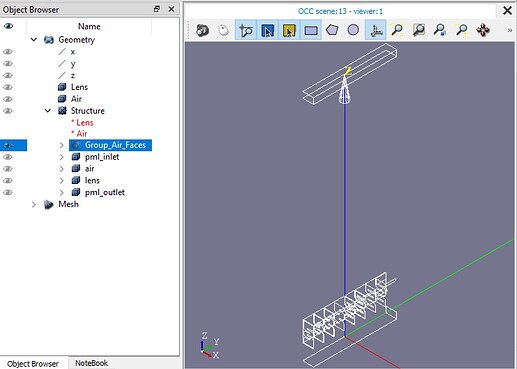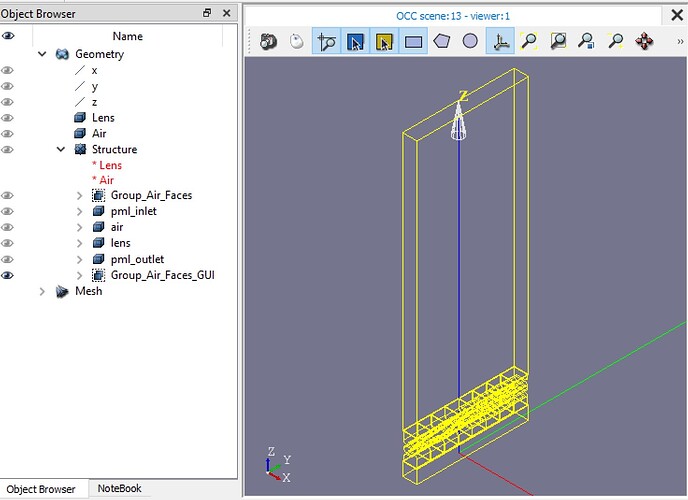Hello,
I am trying to procedurally (Python TUI) create a group of faces and volumes for a complex geometry by adding them to parent partition.
Adding Solids groups work relatively well, although I noticed that I don’t always get the solids list in the same order (e.g. below, Solid_2 references Solid_3 object and vice versa ).
Structure = geompy.MakePartition([pml_bottom, pml_top, lens, air], [], [], [], geompy.ShapeType["SOLID"], 0, [], 0)
solids = [Solid_1, Solid_2, Solid_3, Solid_4] = geompy.ExtractShapes(Structure, geompy.ShapeType["SOLID"], True)
geompy.addToStudy(Structure, 'Structure')
This is a problem as I need to do everything procedurally and I can’t point and click to assign objects to variables.
Another problem that I am facing is when try to assign faces to a group and add it the parent partition. If try to do it procedurally I get a different set of faces than what I get via GUI. For example the code below
# SubFaceListAir = geompy.ExtractShapes(air, geompy.ShapeType["FACE"], True)
# SubFaceListAir = geompy.SubShapeAll(air, geompy.ShapeType["FACE"])
SubFaceListAir = geompy.SubShapeAll(air, geompy.ShapeType["VERTEX"])
SubFaceListAirIDs = [ geompy.GetSubShapeID(air, sf) for sf in SubFaceListAir ]
Group_Air_Faces = geompy.CreateGroup(Structure, geompy.ShapeType["FACE"])
geompy.UnionIDs(Group_Air_Faces, SubFaceListAirIDs)
geompy.addToStudyInFather( Structure, Group_Air_Faces, 'Group_Air_Faces' )
generates a group ‘Group_Air_Faces’ with the following set of faces
If I try to do the same in the GUI, like so
I get the complete set of faces that I was expecting.
If I dump the script before and after the GUI operation, I find that the set of faces generated via TUI
Group_Air_Faces = geompy.CreateGroup(Structure, geompy.ShapeType["FACE"])
geompy.UnionIDs(Group_Air_Faces, [6, 7, 9, 11, 16, 18, 23, 27, 28, 30, 32, 36, 37, 39, 41, 45, 46, 48, 50, 54, 55, 57, 59, 63, 64, 66, 68, 72, 73, 75, 77, 81, 82, 84, 86, 90, 91, 93, 95, 100, 110, 111, 113, 115, 117, 119, 121, 123, 125, 127, 129, 131, 133, 135, 137, 139, 141, 143, 145, 147, 149, 151, 153, 155, 157, 159, 165, 170, 175, 177, 179, 181, 183, 185, 187, 189, 191, 193, 195, 197, 199, 201, 203, 205, 207, 209, 211, 213, 215, 217, 219, 221, 226, 227, 229, 231, 233, 235, 237, 239, 241, 243, 245, 247, 249, 251, 253, 255, 257, 259, 261, 263, 265, 267, 269, 271, 273, 275, 281, 286, 291, 293, 295, 297, 299, 301, 303, 305, 307, 309, 311, 313, 315, 317, 319, 321, 323, 325, 327, 329, 331, 333, 335, 337, 342, 343, 345, 347, 349, 351, 353, 355, 357, 359, 361, 363, 365, 367, 369, 371, 373, 375, 377, 379, 381, 383, 385, 387, 389, 391, 397, 402, 407, 409, 411, 413, 415, 417, 419, 421, 423, 425, 427, 429, 431, 433, 435, 437, 439, 441, 443, 445, 447, 449, 451, 453, 458, 459, 461, 463, 465, 467, 469, 471, 473, 475, 477, 479, 481, 483, 485, 487, 489, 491, 493, 495, 497, 499, 501, 503, 505, 507, 513, 518, 523, 525, 527, 529, 531, 533, 535, 537, 539, 541, 543, 545, 547, 549, 551, 553, 555, 557, 559, 561, 563, 565, 567, 569, 574, 575, 577, 579, 581, 583, 585, 587, 589, 591, 593, 595, 597, 599, 601, 603, 605, 607, 609, 611, 613, 615, 617, 619, 621, 623, 629, 634, 639, 641, 643, 645, 647, 649, 651, 653, 655, 657, 659, 661, 663, 665, 667, 669, 671, 673, 675, 677, 679, 681, 683, 685, 690, 691, 693, 695, 697, 699, 701, 703, 705, 707, 709, 711, 713, 715, 717, 719, 721, 723, 725, 727, 729, 731, 733, 735, 737, 739, 745, 750, 755, 757, 759, 761, 763, 765, 767, 769, 771, 773, 775, 777, 779, 781, 783, 785, 787, 789, 791, 793, 795, 797, 799, 801, 806, 807, 809, 811, 813, 815, 817, 819, 821, 823, 825, 827, 829, 831, 833, 835, 837, 839, 841, 843, 845, 847, 849, 851, 853, 855, 861, 866, 871, 873, 875, 877, 879, 881, 883, 885, 887, 889, 891, 893, 895, 897, 899, 901, 903, 905, 907, 909, 911, 913, 915, 917, 922, 923, 925, 927, 929, 931, 933, 935, 937, 939, 941, 943, 945, 947, 949, 951, 953, 955, 957, 959, 961, 963, 965, 967, 969, 971, 977, 982, 984, 986, 988, 990, 992, 994, 996, 998, 1000, 1002, 1004, 1006, 1008, 1010, 1012, 1014, 1016, 1018, 1020, 1022, 1024, 1026, 1028, 1030, 1074, 1075, 1077, 1079, 1632, 1634, 1639, 1644])
is different from the set generated via GUI
Group_Air_Faces_GUI = geompy.CreateGroup(Structure, geompy.ShapeType["FACE"])
geompy.UnionIDs(Group_Air_Faces_GUI, [1015, 1018, 1025, 34, 66, 1075, 1080, 89, 1128, 1131, 1134, 1137, 1140, 1143, 1146, 1149, 1152, 1155, 1158, 1161, 1164, 1167, 1170, 1173, 1176, 1179, 171, 1182, 1185, 1188, 1191, 1194, 1197, 1200, 1203, 1206, 1208, 1211, 1214, 1217, 1220, 1223, 1226, 1229, 1232, 1235, 1238, 1240, 1243, 1246, 1249, 1252, 1255, 248, 1258, 1261, 255, 1264, 1267, 1270, 1272, 1275, 1278, 1281, 1284, 1287, 1290, 1293, 1296, 1299, 1302, 1304, 1307, 1310, 1313, 305, 1316, 1319, 1322, 1325, 1328, 1331, 1334, 1336, 1339, 1342, 1345, 1348, 1351, 1354, 1357, 1360, 1363, 355, 1366, 358, 1368, 1371, 1374, 365, 1377, 1380, 1383, 1386, 1389, 1392, 1395, 1398, 1400, 1403, 1406, 1409, 1412, 1415, 1418, 1421, 1424, 415, 1427, 1430, 1432, 1435, 1438, 1441, 1444, 1447, 1450, 1453, 1456, 1459, 1462, 1464, 1467, 1470, 1473, 465, 1476, 468, 1479, 1482, 475, 1485, 1488, 1491, 1494, 1496, 1499, 1502, 1505, 1508, 1511, 1514, 1517, 1520, 1523, 1526, 1528, 1531, 1534, 525, 1537, 1540, 1543, 1546, 1549, 1552, 1555, 1558, 1560, 1563, 1566, 1569, 1572, 1575, 1578, 1581, 1584, 575, 1587, 578, 1590, 1592, 585, 1595, 1598, 1601, 1604, 1607, 1610, 1613, 1616, 1619, 1622, 1624, 1627, 1630, 1633, 1636, 1639, 1642, 635, 1645, 1648, 1651, 1654, 1656, 1659, 1662, 1665, 1668, 1671, 1674, 1677, 1680, 1683, 1686, 1690, 685, 1694, 688, 1697, 1700, 1702, 695, 1706, 1709, 1712, 745, 795, 798, 805, 855, 905, 908, 915, 965])
So my questions are:
a) What is missing from my code in order to obtain the same results in terms of faces via TUI as I do via GUI?
b) How do I ensure that in ExtractShape operations I obtain a list of objects consistently ordered?
Many thanks,
Francisco
Best,
Francisco

